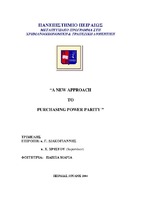Μια νέα προσέγγιση της ισοτιμίας αγοραστικών δυνάμεων (Purchasing Power Parity - PPP)

Master Thesis
Συγγραφέας
Παππά, Μαρία
Ημερομηνία
2004-12-01Προβολή/
Θεματική επικεφαλίδα
Purchasing power parity ; Ισοτιμία αγοραστικής δύναμηςΠερίληψη
The purpose of this study is to evaluate, and hopefully extend the evidence of Purchasing Power Parity (PPP) from the application of both univariate and panel methods. While the issue of how much evidence against the unit root hypothesis in real exchange rates has been found by these tests remains controversial, there appears to be an emerging consensus that the evidence of long-run PPP is stronger now than it was a decade ago and that as time passes and more data becomes available, the evidence of PPP is strengthening.. The question is if this is purely statistical, caused by an increase in the power of unit root tests from the use of additional data and methods, or if economic factors enter into the explanation. We investigate this question by conducting both univariate and panel unit root tests on real exchange rates for the period 1973-2003. The tests use quarterly and monthly data for the 21 countries classified from the IMF as industrialised, with the United States dollar as base currencies. For the univariate tests we first use data from 1973-1988 and then add one by one the data for the precedending years in order to see if by increasing the span of the data the univariate test provides more strengthened evidence of PPP. For the panel tests we construct 7 different panels and conduct the panel tests proposed by Levin and Lin (1993), Im, Pesaran and Shin (1997) and Pesaran (2003). The study is organised as follows. Section 2 discusses the basic concepts of the PPP hypothesis, the absolute and relative PPP versions, the interpretations of PPP and the price index choice in a PPP calculation and the factors responsible for deviations from PPP hypothesis. Section 3 provides a review of the empirical literature on PPP. In Section 4, we focus on the recent econometric developments in the area of testing the PPP hypothesis. In section 5 we provide an up-to-date survey of all the econometric methodologies used in the empirical evaluation of the PPP and conduct our own econometric research. Section 6 gives information about the data and the panels used in our empirical research. Finally, Section 6 provides the concluding remarks.


